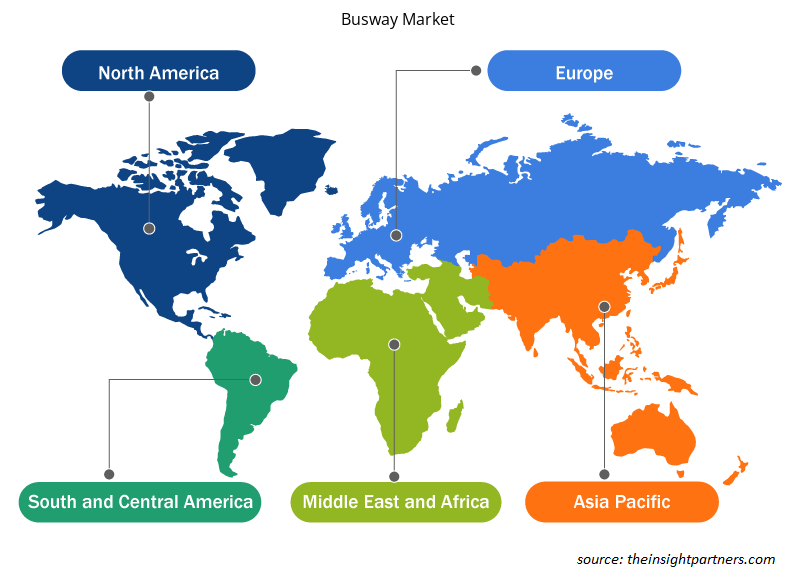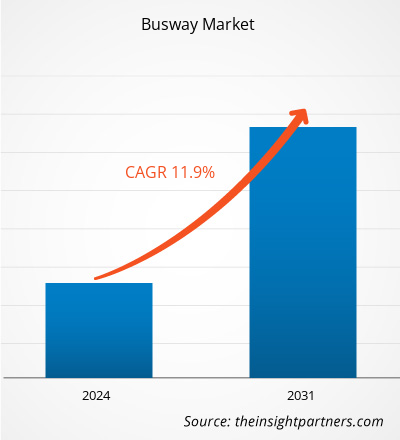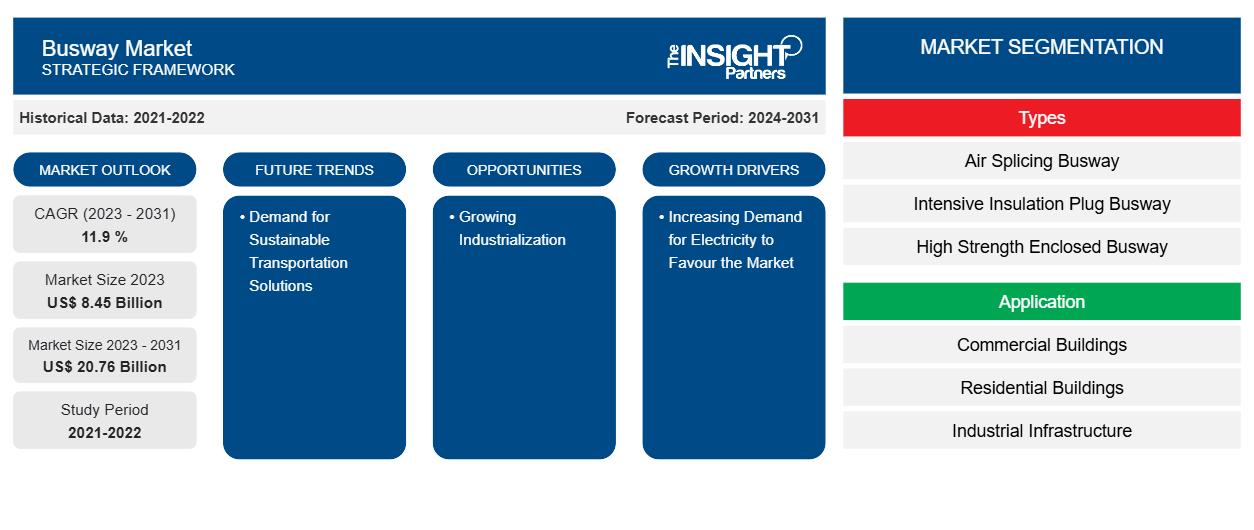Se proyecta que el tamaño del mercado de buses eléctricos alcance los 20.760 millones de dólares en 2031, frente a los 8.450 millones de dólares en 2023. Se espera que el mercado registre una CAGR del 11,9 % entre 2023 y 2031. Es probable que la creciente demanda de electricidad y la creciente industrialización sigan siendo tendencias clave en el mercado de buses eléctricos.
Análisis del mercado de vías para buses
Se observan diferentes tendencias de crecimiento en diferentes regiones de esta industria. Los mercados desarrollados de América del Norte (NA) y Europa (ELI) representan una parte importante de la participación de mercado global; sin embargo, los países en desarrollo en regiones como Asia Pacífico (APAC), Oriente Medio y África (ME), África y América del Sur (SAM) están creciendo rápidamente debido a una variedad de factores como la necesidad de electrificación y el crecimiento de nuevas industrias e infraestructura. Se prevé que la adopción de buses aumente rápidamente en los próximos años debido a la expansión de las redes eléctricas y el desarrollo de plantas de energía renovable a nivel mundial.
Descripción general del mercado de buses
La Asociación Nacional de Fabricantes Eléctricos (NEMA) define un electroducto como un sistema de distribución eléctrica prefabricado compuesto por tramos rectos, accesorios, dispositivos y conexiones, todos encerrados en una carcasa protectora. Los electroductos transportan energía y la vinculan a equipos eléctricos como transformadores, tableros de distribución y aparamenta . En aplicaciones comerciales e industriales, un electroducto es un excelente sustituto de los cables y conductos porque es más fácil de reemplazar, menos costoso de instalar y requiere menos trabajo de configuración, especialmente en escenarios donde es probable que varíen las posiciones de carga.
Personalice este informe según sus necesidades
Obtendrá personalización en cualquier informe, sin cargo, incluidas partes de este informe o análisis a nivel de país, paquete de datos de Excel, así como también grandes ofertas y descuentos para empresas emergentes y universidades.
-
Obtenga las principales tendencias clave del mercado de este informe.Esta muestra GRATUITA incluirá análisis de datos, desde tendencias del mercado hasta estimaciones y pronósticos.
Factores impulsores y oportunidades del mercado de vías para buses
Aumento de la demanda de electricidad para favorecer al mercado.
El uso de electricidad ha aumentado en las últimas décadas y ahora es esencial para las economías modernas. Debido al aumento de la renta disponible, se prevé que esta demanda aumente en los próximos años. El aumento del consumo de electricidad ha dado lugar a un aumento del uso de electricidad en las industrias de consumo final y en los automóviles. Existen dos patrones geográficos diferentes para la demanda de electricidad. Las mejoras en la eficiencia energética contrarrestan el crecimiento futuro asociado con el aumento de la electrificación y la digitalización en las economías avanzadas.
Creciente industrialización
La creciente industrialización conduce al desarrollo de nuevas fábricas y plantas de fabricación, que requieren una infraestructura eléctrica robusta para alimentar maquinarias y equipos, creando una demanda de sistemas de buses para distribuir eficientemente la electricidad.busway systems to efficiently distribute electricity.
Análisis de segmentación del informe de mercado de vías para buses Market Report Segmentation Analysis
Los segmentos clave que contribuyeron a la derivación del análisis del mercado de buses son los tipos y las aplicaciones.busway market analysis are types and applications.
- Según los tipos, el mercado de electroductos se divide en electroductos con empalme de aire (BMC), electroductos con tapones de aislamiento intensivo (CMC), electroductos cerrados de alta resistencia (CFW) y otros.busway market is divided into air splicing busways (BMC), intensive insulation plugs busways (CMC), high-strength enclosed busways (CFW), and others).
- Por aplicación, el mercado está segmentado en edificios comerciales, edificios residenciales, infraestructura industrial y otros.
Análisis de la cuota de mercado de los buses por geografía Market Share Analysis by Geography
El alcance geográfico del informe de mercado de buses de buses se divide principalmente en cinco regiones: América del Norte, Asia Pacífico, Europa, Oriente Medio y África, y América del Sur/América del Sur y Central. América del Norte ha dominado el mercado de buses de buses. Las tendencias de adopción de alta tecnología en varias industrias en la región de América del Norte han impulsado el crecimiento del mercado de buses de buses. Además, un fuerte énfasis en la investigación y el desarrollo en las economías desarrolladas de los EE. UU. y Canadá está obligando a los actores norteamericanos a traer soluciones tecnológicamente avanzadas al mercado. Además, los EE. UU. tienen muchos actores del mercado de buses de buses que se han centrado cada vez más en el desarrollo de soluciones innovadoras. Todos estos factores contribuyen al crecimiento del mercado de buses de la región.busway market report is mainly divided into five regions: North America, Asia Pacific, Europe, Middle East & Africa, and South America/South & Central America. North America has dominated the busway market. High technology adoption trends in various industries in the North American region have fuelled the growth of the busway market. Moreover, a strong emphasis on research and development in the developed economies of the US and Canada is forcing the North American players to bring technologically advanced solutions into the market. In addition, the US has many busway market players who have been increasingly focusing on developing innovative solutions. All these factors contribute to the region's growth of the busway market.
Perspectivas regionales del mercado de buses
Los analistas de Insight Partners explicaron en detalle las tendencias y los factores regionales que influyen en el mercado de vías para buses durante el período de pronóstico. Esta sección también analiza los segmentos y la geografía del mercado de vías para buses en América del Norte, Europa, Asia Pacífico, Oriente Medio y África, y América del Sur y Central.

- Obtenga los datos regionales específicos para el mercado de vías para buses
Alcance del informe de mercado de vías para buses
| Atributo del informe | Detalles |
|---|---|
| Tamaño del mercado en 2023 | US$ 8,45 mil millones |
| Tamaño del mercado en 2031 | US$ 20,76 mil millones |
| CAGR global (2023 - 2031) | 11,9 % |
| Datos históricos | 2021-2022 |
| Período de pronóstico | 2024-2031 |
| Segmentos cubiertos |
Por tipos
|
| Regiones y países cubiertos |
América del norte
|
| Líderes del mercado y perfiles de empresas clave |
|
Densidad de actores del mercado de buses: comprensión de su impacto en la dinámica empresarial
El mercado de buses está creciendo rápidamente, impulsado por la creciente demanda de los usuarios finales debido a factores como la evolución de las preferencias de los consumidores, los avances tecnológicos y una mayor conciencia de los beneficios del producto. A medida que aumenta la demanda, las empresas amplían sus ofertas, innovan para satisfacer las necesidades de los consumidores y aprovechan las tendencias emergentes, lo que impulsa aún más el crecimiento del mercado.
La densidad de actores del mercado se refiere a la distribución de las empresas o firmas que operan dentro de un mercado o industria en particular. Indica cuántos competidores (actores del mercado) están presentes en un espacio de mercado determinado en relación con su tamaño o valor total de mercado.
Las principales empresas que operan en el mercado de buses son:
- Schneider Electric
- Siemens
- Comer
- Cables y sistemas LS
- Conducto de bus de enchufe de alimentación Sdn. Bhd.
- TEJIDO
Descargo de responsabilidad : Las empresas enumeradas anteriormente no están clasificadas en ningún orden particular.

- Obtenga una descripción general de los principales actores clave del mercado Busway
Noticias y desarrollos recientes del mercado de vías para buses
El mercado de buses se evalúa mediante la recopilación de datos cualitativos y cuantitativos a partir de investigaciones primarias y secundarias, que incluyen publicaciones corporativas importantes, datos de asociaciones y bases de datos. A continuación, se incluye una lista de los avances del mercado:
- En junio de 2021, la empresa de gestión energética Eaton anunció que había completado la adquisición de una participación del 50 por ciento en el negocio de electroductos de Jiangsu YiNeng Electric, que fabrica y comercializa productos de electroductos en China y tuvo ventas de US$60 millones en 2020.
(Fuente: Eaton, nota de prensa, 2021)
Informe sobre el mercado de vías para buses: cobertura y resultados
El informe "Tamaño y pronóstico del mercado de vías para buses (2021-2031)" proporciona un análisis detallado del mercado que cubre las siguientes áreas:
- Tamaño del mercado y pronóstico a nivel global, regional y nacional para todos los segmentos clave del mercado cubiertos bajo el alcance
- Dinámica del mercado, como impulsores, restricciones y oportunidades clave
- Principales tendencias futuras
- Análisis detallado de las cinco fuerzas de Porter y PEST y FODA
- Análisis del mercado global y regional que cubre las tendencias clave del mercado, los principales actores, las regulaciones y los desarrollos recientes del mercado.
- Análisis del panorama de la industria y de la competencia que abarca la concentración del mercado, el análisis de mapas de calor, los actores destacados y los desarrollos recientes
- Perfiles detallados de empresas
- Análisis histórico (2 años), año base, pronóstico (7 años) con CAGR
- Análisis PEST y FODA
- Tamaño del mercado, valor/volumen: global, regional y nacional
- Industria y panorama competitivo
- Conjunto de datos de Excel
Informes recientes
Testimonios
Razón para comprar
- Toma de decisiones informada
- Comprensión de la dinámica del mercado
- Análisis competitivo
- Información sobre clientes
- Pronósticos del mercado
- Mitigación de riesgos
- Planificación estratégica
- Justificación de la inversión
- Identificación de mercados emergentes
- Mejora de las estrategias de marketing
- Impulso de la eficiencia operativa
- Alineación con las tendencias regulatorias























 Obtenga una muestra gratuita para - Mercado de vías de autobús
Obtenga una muestra gratuita para - Mercado de vías de autobús